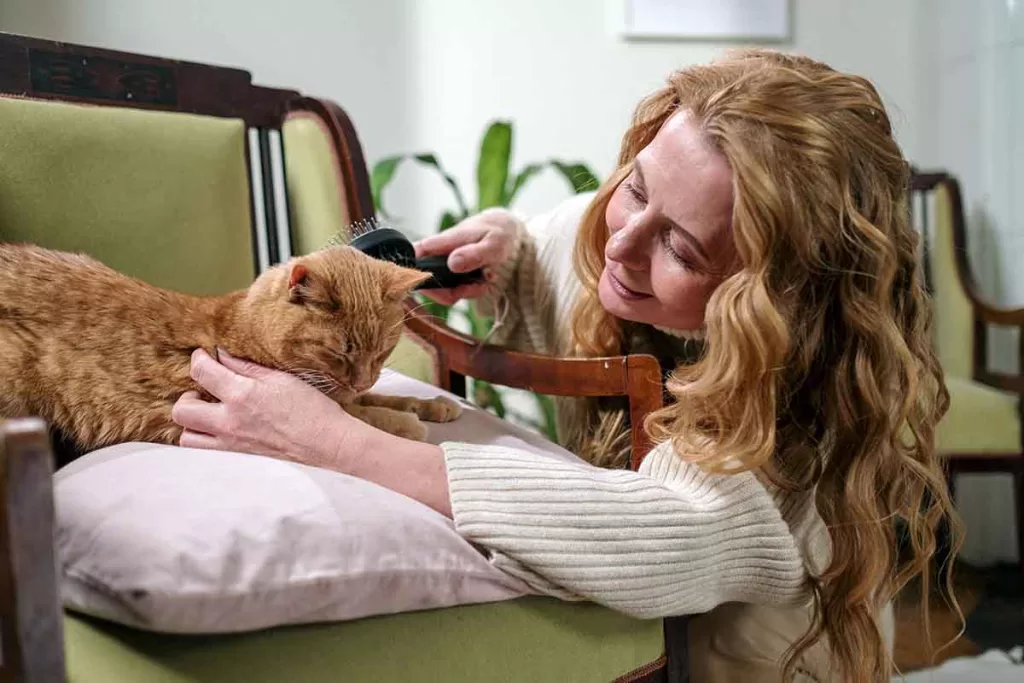It can be hard to leave your pets behind when life demands it. Whether you’re going away for work, vacationing with the family, or simply taking an extended weekend break—finding someone who you can trust to take care of your cat is essential.
A cat sitter provides short-term, in-home pet care services while you are away. They drop in daily or stay overnight if needed, to feed and care for your cat and provide companionship. Hiring a cat sitter ensures that your cat will be cared for in familiar surroundings until you get home.
This article explores what a professional cat sitter does and how having one on hand helps pet owners during those times when they have to be away from home.
What Is A Cat Sitter?
A cat sitter is a professional pet sitter who specializes in taking care of cats, offering a service where they will come to your home and look after your cat while you are away. They will provide your cat with companionship and take care of its daily needs, giving you peace of mind.
Services can include drop-in visits, where the sitter will come to your home for a predetermined amount of time each day. They can also include overnight stays, where the cat sitter will stay in your home and look after your pet while you are away.
Some cat sitters may also offer boarding services, where you can leave your cat with them in their home instead of yours. Cat owners might find this preferable if they are not comfortable with having a stranger in their house but they don’t want to take their pet to a boarding kennel either.
What Does A Cat Sitter Do?
A cat sitter will provide daily care for your cat while you are away, including feeding, grooming, and playing. They may also administer any medications that your pet might need during their stay if this is agreed upon ahead of time.
If you’re leaving town for an extended period of time, a cat sitter can also help with basic maintenance tasks such as cleaning the litter box. They can also provide you peace of mind by providing you with daily updates on how your pet is doing in your absence.
How much time the sitter spends with your cat will depend on the arrangements that you agree to in advance. They may come to your house once or twice a day for a specified amount of time, or they may spend the night or even the entire day.
Cat sitters may also be engaged as “house sitters”, where they are responsible not only for looking after your cat but also for keeping an eye on your house while you are away.
They will monitor the property, take in mail and other deliveries, water plants and perform any other tasks that you request during their stay. Of course, this must all be agreed to in advance, and the sitter must be paid accordingly.
Should A Cat Sitter Come In Every Day?
Cats should not be left for longer than a day or two without having someone checking in on them. If you are going to be gone long enough to warrant hiring a cat sitter, then the sitter should be dropping in at least once every day.
However, some cats need more attention and companionship than others. Cats in multi-cat households where cats have each other for company tend to need human companionship less often than cats who are the only pet.
Cats are social creatures, and they get lonely when left by themselves for long stretches of time. If your cat is the only cat in the home, it is usually better to have the sitter stay at your home rather than just dropping in once a day.
You can find more tips on leaving your cat home alone in our article on the topic which can be found here.

How Long Can I Leave My Cat With A Sitter?
The amount of time that you can leave your cat with a sitter really depends on your particular situation. If the sitter is staying at your home with your cat and the cat likes its sitter, then there would be little issue with leaving your cat with the sitter for several weeks.
However, if the sitter is just dropping in once or twice a day, you will not want to be leaving your at for weeks at a time. Cats who are closely bonded with their owners will still be lonely, anxious, and stressed even if their physical meets are being met.
Even with a sitter dropping in daily, I would not recommend leaving your cat for longer than one week at a time.
How Much Time Should The Cat Sitter Spend With My Cat?
The amount of time that the sitter spends with your cat should be based on a few factors. The breed and personality of your cat, their age, and any special physical or medical needs that they may have all need to be taken into consideration.
Generally speaking though, the minimum amount of time a cat sitter should spend with your cat is half an hour per visit. This provides time to feed the cat, check on their overall well-being, clean the litter box, and provide some playtime.
Make sure you agree on the amount of time with the sitter ahead of time. Their drop-in fee may include a half hour of their time, and if you request more time then their fee may be higher.
How Do I Prepare My Cat For A Cat Sitter?
The best way to ensure a successful cat-sitting experience is to make sure your cat is comfortable with the sitter before they start their visits. The more prepared you are, the less stressful it will be for both you and your pet.
Start by making sure your cat has had a chance to get used to the scent of the sitter. Place some of the sitter’s clothing or a towel around your home and let your cat investigate it in their own time.
You can also arrange for the cat sitter to come over for a meet-and-greet session before you leave town. This will give both parties a chance to get to know each other and ensure a comfortable relationship.
Having the sitter come over ahead of time also lets them get familiar with your home. You can show them where the food is kept, where the litter box is, and where your cat’s favorite hiding spots are, for example.
Finally, make sure you leave your cat sitter with detailed instructions about their routine, dietary preferences, any medical conditions or special needs the cat may have, and anything else that will help them provide the best care for your pet.
How Much Do I Pay A Cat Sitter?
The rates for cat sitters can vary considerably, varying with the sitter’s experience and certifications and with the region you live in. It will also vary with how much time you want the sitter to spend with your cat.
For example, a quick search for cat sitters in the Los Angeles, CA area on the website Rover found that, on the front page of search results, rates ranged from $14-$45 USD per drop-in visit in Los Angeles with an average of around $25 per visit.
On the other hand, the same search for a cat sitter in the Billing, MT area found rates in the range of $11-$45, with an average of around $20 per visit.
When you find a cat sitter that meets your needs and is available for the time that you need them, negotiate their rate in advance and put it in writing so that there is no misunderstanding down the road.

Should I Tip My Cat Sitter?
Cat sitting is a service, and the standard rate for tipping in the service industry is 20%. It is up to you whether you want to tip your sitter or not, but if you feel that the sitter did an outstanding job with your pet then it’s always nice to add something extra to your payment.
Tipping is also a good way to show your appreciation and build a strong relationship with your cat sitter. Your cat sitter will be more likely to accommodate any special requests you may have in the future if you show them that you value their time and dedication to providing quality care for your pet.
Cat sitting isn’t just a job – it’s an act of love. So, when it comes time to tip your cat sitter, keep in mind the exceptional care and companionship that they are providing for your cat.
No matter what you decide to do, make sure to thank your cat sitter for all their hard work – it’s always appreciated!
How Do I Become A Cat Sitter?
If you love cats and have a passion for providing them with quality care, you may consider becoming a cat sitter.
The first step is to make sure that you are legally allowed to provide pet-sitting services in the area where you live. Laws vary from state to state, so be sure to check the laws in your area.
Once you’ve established that it is legal to provide cat-sitting services, start researching the different pet-sitting certifications available and decide which ones you want to pursue.
Many of these are offered online and can be completed in a matter of weeks or months depending on the coursework required.
Once you’ve obtained the necessary certifications, create a professional profile on pet-sitting websites such as Rover or Pet Sitters International and start marketing your services.
You can also reach out to local pet owners by posting flyers in areas that cater to pet owners or joining local networking groups.
Conclusion
Cat sitting is a great alternative to boarding your cat when you’re away from home. It provides an easy and convenient way for you to make sure your pet stays safe and happy by allowing your cat to stay in the comfort of their own home while you’re away.
Before hiring a sitter, take the time to research their experience and qualifications, arrange for a meet-and-greet session, and provide detailed instructions about your cat’s routine.
Thank you for taking the time to read about cat sitting. We hope this article has been helpful.
Happy travels!



